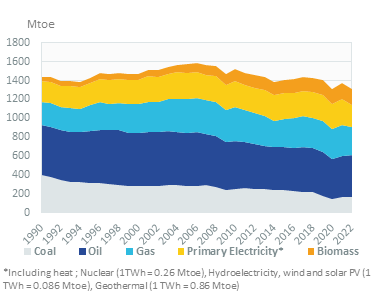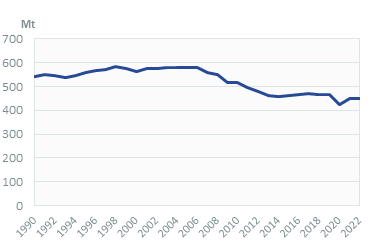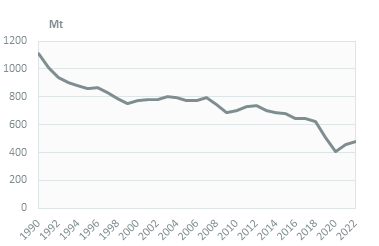-
-
 Energy and Climate Databases
Energy and Climate Databases- The most comprehensive and up-to-date annual energy database.
- Monitoring of technology providers in H2 supply chain.
- Monthly energy data on key energy markets.
- The most reliable and up-to-date power generation database.
- The essentials of LNG trade at your fingertips.
- Global monitoring of new and existing refineries.
- Analyse energy consumption and efficiency trends at world level. Benchmark countries.
- Have your database developed by a recognised expert of both energy and IT.
-
 Energy - Climate Forecasts
Energy - Climate Forecasts- Instant access to energy and emissions forecasts.
- Strategic, annual wholesale price projections backed by Enerdata's energy modelling expertise and our globally recognised POLES model.
- Wedges module showing a breakdown of the levers enabling to reduce emissions between two scenarios.
- Unique, independent projections of consumption by end-use.
- GHG Marginal Abatement Cost Curves.
- Benefit from proven models to draw your own energy scenarios and anticipate tomorrow’s challenges.
-
 Market Intelligence
Market Intelligence- 110 Energy and climate country reports
- A newsletter to receive the latest updates on evolving technologies and policies.
- Global energy news and analyses curated daily.
- Enerdata’s experts bring you the essentials about your market and competitors.
-
-
-
 Market Analysis
Market Analysis- Understanding key consumption trends and drivers across sectors.
- Granular and exclusive insight to address the most pressing business and strategic issues.
- Expertise in strategic and business intelligence, with fine-tuning to the market’s specificities.
-
 Energy - Climate Scenarios
Energy - Climate Scenarios- Providing the outlook of an energy commodity in mid to long term time horizons.
- Sector and driver specific energy demand forecasting.
- Assess the evolution of energy prices on the international and regional markets, as well as end-users prices.
- Enerdata guides you through pathways to reach climate targets.
- Supporting local authorities in their decarbonisation strategies.
-
 Climate Strategy and Policy Evaluation
Climate Strategy and Policy Evaluation- Cutting-edge quantitative tools and relevant indicators to monitor and evaluate evolutions on worldwide energy markets.
- Analysis of the most cost-effective options to reduce emissions.
- Quantified simulation and analysis of pledges for climate change negotiations.
- Breakdown and analysis of carbon markets.
- Enerdata guides you on the most beneficial policy or investment options.
- Turning climate objectives into concrete action plans.
-
 Training
Training- Understand different policy targets and measures on energy efficiency.
- How to measure energy savings?
- Energy Forecasting is a 2 days training to learn to design and interpret energy forecasts.
- Energy statistics training allowing to create energy balance with supply, transformation and consumption and understanding the international energy statistics regulations.
- Initiation to EnerMED level 1is the training to approach on the most powerful energy demand forecasting model.
-
-
Resource Centre
European Union Key Figures
- Population:
- 448 million
- GDP growth rate:
- 3.65 %/year
- Energy independence:
- 42.9 %
Data of the last year available: 2022
- Total consumption/GDP:*
- 66.7 (2005=100)
- CO2 Emissions:
- 5.90 tCO2/capita
- Rate of T&D power losses:
- 39.7 %
* at purchasing power parity
View all macro and energy indicators in the European Union energy report
European Union Related News
View all news, archive your new and create your own daily newsletters only on your topics/countries of interest with Key Energy Intelligence
European Union Related Research
Benefit from up to 2 000 up-to-date data series for 186 countries in Global Energy & CO2 data
A data overview is available in the global energy statistics app
Total Energy Consumption
Total energy consumption per capita is 2.9 toe (compared to 6.5 toe in the United States and 2.7 toe in China). Electricity consumption per capita is around 5 600 kWh (compared to 12 200 kWh in the United States and 5 800 kWh in China).
Graph: CONSUMPTION TRENDS BY ENERGY SOURCE (Mtoe)

Graph: TOTAL CONSUMPTION MARKET SHARE BY ENERGY (2022, %)

Interactive Chart European Union Total Energy Consumption
Benefit from up to 2 000 up-to-date data series for 186 countries in Global Energy & CO2 data
View the detailed fondamentals of the market at country level (graphs, tables, analysis) in the European Union energy report
Crude Oil Production
Crude oil and NGL production is limited and decreasing, reaching 21 Mt in 2022 (-39% since 2010); imports of crude oil represented 93% of its consumption.
In 2022, less than a fifth of the EU's crude oil imports came from Russia (compared to a quarter in 2021), followed by Norway (11%) and the United States (10%).
The EU produced 535 Mt of oil products in 2022, covering its entire consumption. Output has increased by 3.9%/year since 2020. It remains below its pre-Covid-19 level (563 Mt in 2019).
Interactive Chart European Union Crude Oil Production
Benefit from up to 2 000 up-to-date data series for 186 countries in Global Energy & CO2 data
Additionally, for more detailed information on refineries, you can request a sample of our EMEA Refineries Dataset
Oil Products Consumption
Oil consumption remained stable in 2022, following a 5% increase in 2021 and a 9% drop in 2020. Previously, oil consumption remained stable from 2013 to 2019 and declined by 3%/year over 2007-2013.
Graph: OIL CONSUMPTION (Mt)

In 2022, transport represented 58% of the oil consumption, followed by industry (including non-energy uses) with 20% and residential services & agriculture with 11%.
Graph: OIL CONSUMPTION BREAKDOWN BY SECTOR (2022, %)
Interactive Chart European Union Refined Oil Products Production
Benefit from up to 2 000 up-to-date data series for 186 countries in Global Energy & CO2 data
Additionally, for more detailed information on refineries, you can request a sample of our EMEA Refineries Dataset
Natural Gas Consumption
Gas consumption declined by 13% in 2022 to 368 bcm and by 8% in 2023, according to ACER. Previously, it remained relatively stable at around 400 bcm between 2017 and 2021.
Graph: NATURAL GAS CONSUMPTION (bcm)

Buildings (residential and services sector) accounted for 37% of total gas consumption; the remaining amount is consumed in electricity production (30%) and in industry (27%) (2022).
Interactive Chart European Union Natural Gas Domestic Consumption
Benefit from up to 2 000 up-to-date data series for 186 countries in Global Energy & CO2 data
Additionally, for more detailed information on the LNG trade, you can request a sample of our EMEA LNG Trade Dataset
Coal Consumption
Since 2020, coal and lignite consumption has increased by 8%/year, reaching 476 Mt in 2022. Lignite represents the bulk of this consumption (65%). It has declined since 1990 (-57%), with an acceleration since 2010 (-32%).
Graph: COAL CONSUMPTION (Mt)

Power generation is the main consumer of coal and lignite, with a share of 80% (82% in 2010), followed by industry with 11%.
Graph: COAL CONSUMPTION BREAKDOWN BY SECTOR (2022, %)
Interactive Chart European Union Coal and Lignite Domestic Consumption
Benefit from up to 2 000 up-to-date data series for 186 countries in Global Energy & CO2 data
View the detailed consumption trends at country level (graphs, tables, analysis) in the European Union energy report
Power Consumption
Electricity consumption decreased by 3% in 2022 and by 3.4% in 2023, according to ACER. It was roughly stable between 2005 and 2021 at around 2 500 TWh.
Graph: ELECTRICITY CONSUMPTION (TWh)

The industrial sector is the largest electricity consumer with 35% of total electricity consumption in 2022. The residential and services sector have a similar market share (29 and 28%, respectively).
Graph: ELECTRICITY CONSUMPTION BREAKDOWN BY SECTOR (2022, %)
Renewable in % Electricity Production
The Renewable Energy Directive is the legal framework for the development of renewable energy in the EU economy.
Interactive Chart European Union Share of Renewables in Electricity Production (incl hydro)
Benefit from up to 2 000 up-to-date data series for 186 countries in Global Energy & CO2 data
Learn more about renewables in the European Battery Market Analysis
CO2 Fuel Combustion/CO2 Emissions
Total GHG emissions (UNFCCC definition) increased by 6% in 2021 after a 15% reduction between 2017 and 2020 (of which 8.4% in 2020). They stood at 3.24 GtCO2eq in 2021, which is 30% below their 1990 level (LULUCF included).